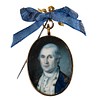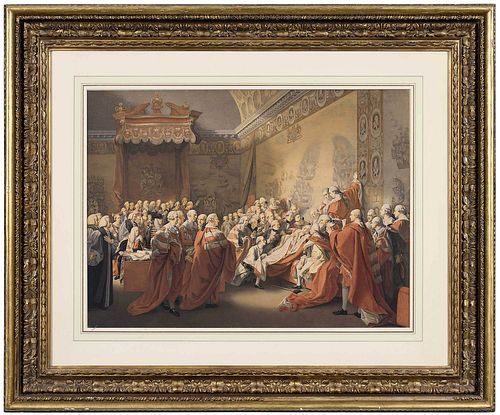After John Singleton Copley
Bid Increments
| Price | Bid Increment |
|---|---|
| $0 | $25 |
| $100 | $50 |
| $1,000 | $100 |
| $2,000 | $200 |
| $3,000 | $250 |
| $5,000 | $500 |
| $10,000 | $1,000 |
| $20,000 | $2,000 |
| $50,000 | $5,000 |
| $100,000 | $10,000 |
(American, 1737-1815)
The Death of the Earl of Chatham, after the painting held by The Tate Gallery on loan to the National Portrait Gallery, London, possibly executed circa 1780 by Henry Cipriani, youngest son of Giovanni Battista Cipriani, commissioned by Francesco Bartolozzi, watercolor on laid paper, sheet 22-1/8 x 30 in.; period gilt wood frame, 37-3/4 x 45-3/4 in.
Note: "The drawing from the original picture for Bartolozzi's use in copying was executed in water colours by Henry, youngest son of Cipriani. It was said to be the most carefully made, and the copyist received a hundred guineas and considerable praise." (Tuer, pg.103). This composition has an additional portrait head behind the proper left shoulder of Lord Onslow (#14) who holds a stick (See: https://wellcomecollection.org/works/fqjfg7ve). It bears some resemblance to Copley.
The historical context is discussed in a note for the original painting posted by the National Portrait Gallery, London. It states, "The painting represents the dramatic collapse of William Pitt, 1st Earl of Chatham, in the House of Lords on 7 April 1778. Chatham had just delivered a speech urging for a peace settlement with the revolutionary Americans. In order to preserve the empire, he had done so much to build up, Chatham called for any form of settlement short of total independence. On rising, for a second time, to rebut the Duke of Richmond's motion that the American colonies be given independence, Chatham suffered a heart attack. The fallen Chatham is surrounded by his three sons and his son-in-law (Lord Mahon) and supported by the Dukes of Cumberland and Portland. Chatham never recovered and died a month later at his country estate
Lord Camden who was sitting beside Chatham described the scene in a letter to the Duke of Grafton: 'He fell back upon his seat and was to all appearance in the agonies of death. This threw the whole House into confusion .... even those who might have felt a secret pleasure at the accident, yet put on the appearance of distress, except only the Earl of Mansfield, who sat still, almost as much unmoved as the senseless body itself.'
The American Copley, following the example of his compatriot Benjamin West, employed the heightened emotions and grand gestures of traditional history painting to a contemporary event. The portraiture is direct, being based on individual studies, but considerable license has been taken in the theatrical composition and the lighting. The painting excited much controversy when exhibited in 1781."
References:
Bartolozzi?s engraving of this composition: https://www.britishmuseum.org/collection/object/P_1878-0511-809
Literature:
Tuer, Andrew White. Bartolozzi and His Works: A Biographical and Descriptive Account of the Life and Career of Francesco Bartolozzi, R.A. (Illustrated) : with Some Observations on the Present Demand for and Value of His Prints ... : Together with a List of Upwards of 2,000 ... of the Great Engraver's Works. London: Field & Tuer, 1882. pg. 101 ;
Prown, Jules David. John Singleton Copley: In England, 1774-1815.. Cambridge, Mass: Harvard Univ. Press, 1966, pg 437, No. 2;
Bayley, Frank W., and Augustus Thorndike Perkins. The Life and Works of John Singleton Copley, Founded on the Work of Augustus Thorndike Perkins. Boston: Taylor Press, 1915.
Provenance: Knoedler & Co., New York
Condition
mounted to larger paper sheet then laid on card, gilt border, some abrasions on surface, toning, fading;
Purchased items will be available for pick up or shipping from our Asheville, North Carolina auction facility within ten business days of the auction will be assessed a storage fee of $5.00 per day, per item. Purchaser agrees that packing and shipping is done at the purchaser's risk and that the purchaser will pay in advance all packing expenses, materials, carrier fees and insurance charges. At our discretion, items will either be packed by an agent such as a packaging store or Brunk Auctions. Please allow two weeks for shipping after payment is received. Shipment of large items is the responsibility of the purchaser. We are happy to provide names of carriers and shippers if a purchaser so requests. Brunk Auctions will have no liability for any loss or damage to shipped items.
























